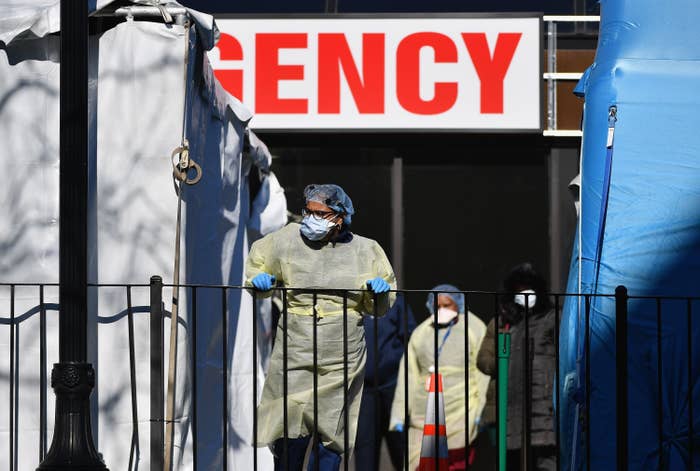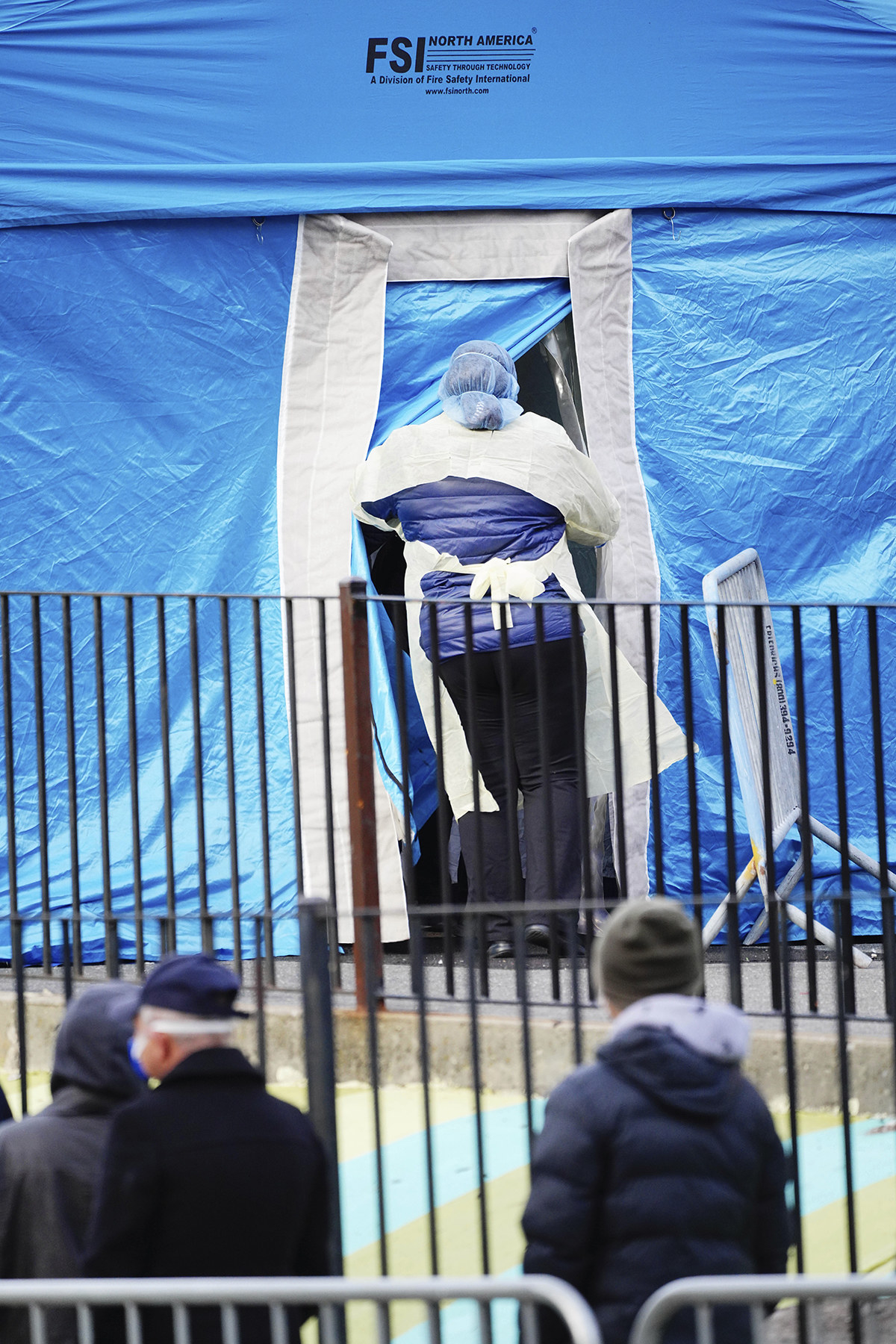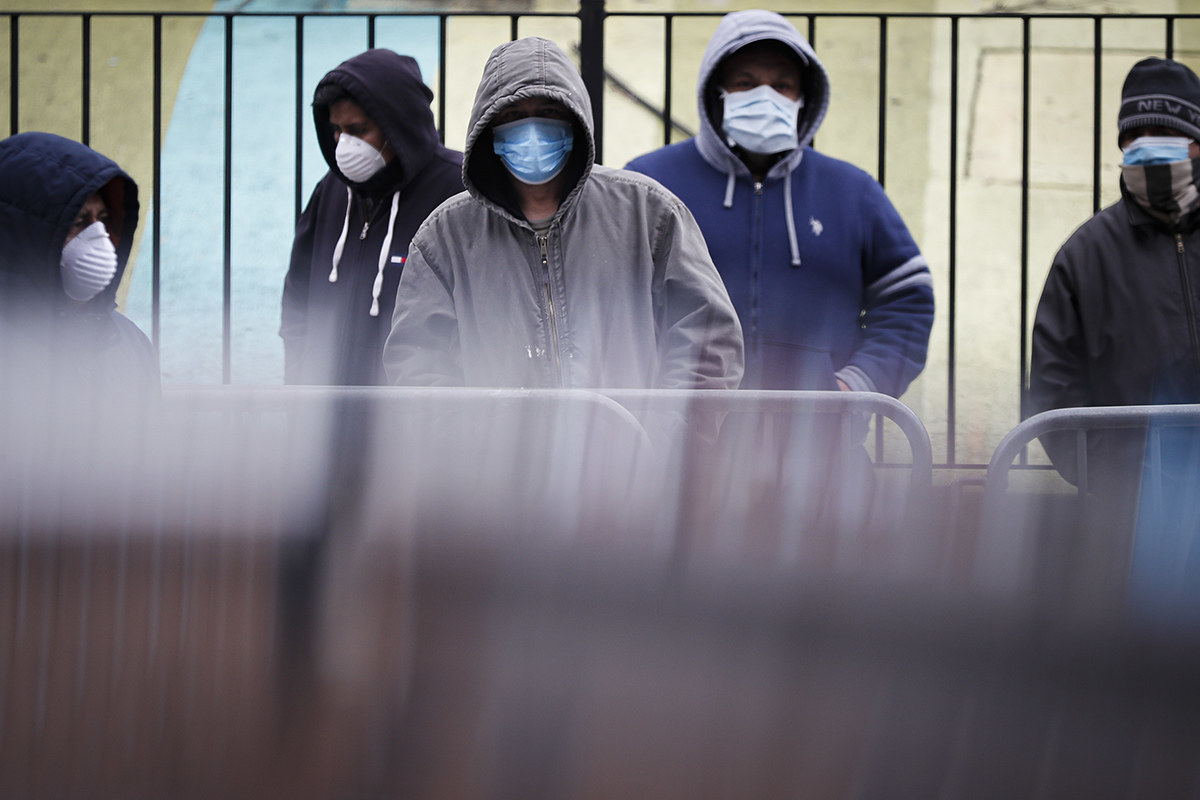
The journalists at BuzzFeed News are proud to bring you trustworthy and relevant reporting about the coronavirus. To help keep this news free, become a member and sign up for our newsletter, Outbreak Today.
The center of New York City’s coronavirus crisis is Elmhurst Hospital Center. The 545-bed facility, in Queens, has in recent days experienced the full brunt of an unprecedented public health crisis: long lines to receive medical care, a chaotic emergency room, supplies and equipment dwindling dangerously low, an overfull morgue, and medical workers themselves contracting and suffering from the virus. On Wednesday, the New York Times reported that 13 patients died at Elmhurst from COVID-19, the disease caused by the novel coronavirus, in the preceding 24-hour period.
The area the hospital serves — what the New Yorker’s Rivka Galchen called in 2013 “the most diverse neighborhood in New York City and maybe in the world” — is a hub for immigrants. According to Galchen’s story, the hospital offers translation services in 153 languages. As such, it’s not just a symbol of the city’s straining public health system, but the immigrant city itself.
Last night, BuzzFeed News spoke with a physician at Elmhurst who has been treating coronavirus patients. The doctor, who estimated that there are currently around 60 intubated COVID-19 patients at the hospital, requested anonymity so he could speak freely. This interview has been edited and condensed for clarity.
Describe what’s happening in the hospital right now.
Elmhurst is just getting destroyed. It’s very, very gruesome. The hospital has a 15-bed intensive care unit that would normally cover respiratory patients or patients with any significant illness requiring intubation, like pneumonia, liver injury, encephalopathy, or kidney problems. What’s remarkable is that now, every patient is a COVID patient. And they’re all ARDS [acute respiratory distress syndrome, a life-threatening fluid buildup in the lungs].
There is a nine-bed medical intensive care unit — those are all ARDS. Then you have a 30-bed stepdown unit. That’s all intubated COVID patients. Then there’s the general medicine floor. That’s all intubated COVID patients. You walk into the hospital and you think, Not only is the virus infecting people — it’s infecting the hospital itself. It’s pushing out everything else. It’s all COVID. That’s insane.
To make things worse, Elmhurst, which basically is held together by a shoestring in the best of times, is being pushed to the brink.
Being pushed to the brink, how?
The hospital used to have four pulmonology and critical attendings [doctors who specialize in treating critical respiratory illness]. Four attendings seems small but it’s usually fine. When you’re asking them to see five to six times the number of patients as normal, it becomes absurd. One of those attendings left a month ago, and one is sick. So now you have two attending physicians seeing all these patients. And now you have normal medicine teams who are used to seeing diarrhea, alcohol withdrawal, UTIs, stuff that is very mild, who are now being asked to deal with the most complicated, intubated, multi-organ failure patients. I’ve never seen anything like it before.
They might be intubated and vented but just lying in the ER and waiting.
The ER has a huge backflow of patients. Like there might be 12 patients designated for admission but there are no beds. These people are in purgatory. The emergency room has to manage them as a team. They might be intubated and vented but just lying in the ER and waiting while ER doctors are tending to however many people they have to see on their shift. These vented patients are very complicated. You have to check blood gasses every few hours to make sure you’re pushing in the right amount of oxygen and pulling out the right amount of carbon dioxide. There are people called respiratory techs who go to school for years for that. Normally you get a respiratory tech with a vented patient, but they’re spread so thin here.
COVID is a very deadly disease. Even with a perfect 1-to-1 ratio of doctors and perfect staffing, a lot of these people are going to die. But there are things you can do with more oversight and more expertise. The issue with Elmhurst is there aren’t enough intensivists — not enough specialists in respiratory disease. Everyone is trying to pitch in but people are being stretched very thin.

Do staff have enough personal protective equipment (PPE)?
It’s a motley collection. Everyone is wearing a mask. Everyone has a different assemblage of gear. The hospital is low on PPE. Some people bring in face shields from home. Some are wearing goggles. Some are wearing hair nets. Some are walking around in cutaway scrubs. Some have yellow gowns on top of the scrubs. Some people have helmets.
You’re supposed to wear an N95 mask with a face shield down, gloves, and when you’re done, you’re supposed to throw everything out. Now, there’s a shortage. And the hospital has so much infection, plus people’s technique is not perfect. People are very scared so they’re wearing one N95 all day, which — I don’t know how legitimate that is — then they put a different surgical mask on top of that one, then throw it out. I have one face shield that I have to keep rewashing after seeing every patient.

Who are the COVID patients, demographically?
Elmhurst is a super-diverse community. It’s Hispanic, Bengali, Pakistani, Polish, Guyanese. It’s everybody. It’s our normal patient population. The ages are terrifying, anywhere from thirties, forties, fifties, sixties, seventies. It’s obviously more people in their sixties and seventies. But every time there is a code [a cardiac arrest and medical response], they call out the room. And when they call out the room, residents run to their computer and look who is coding and how old they are. Today there were two 35-year-olds who died. And people are so freaked out by that.
Today there were two 35-year-olds who died.
It tends to be someone with a preexisting condition — one of these people had asthma, and one had obstructive sleep apnea. But this is mild stuff. We’re not talking about only quadriplegics. We’re talking about people who are basically doing well.
How is the morale of the staff?
It’s pretty common to see someone crying in the hallway. I saw that twice today. Something like 12 people died yesterday. [The New York Times reported 13 deaths.] These are bonkers numbers for a hospital, where you’d usually have one or two a day. They don’t even change in and out of PPE. They gear up one time, and that’s it for the whole shift. They don’t want to be exposed for a second, and lots of them are already calling out with fevers. The morale among ER people is extremely low. People are anxious, making morbid jokes about dying. Talking about what would happen if I quit, I didn’t sign up for this.
The chatter you hear outside of these units is very grim. An attending will come in and say, “I’m flashing back to Vietnam” or “it’s a fucking nightmare” or “this box of masks will last until Friday.” It’s bad.
There’s no visitors allowed in the hospital now so these people are dying alone.
The patients are all silent. Because they are being intubated and in medically induced comas. Normally patients this sick are surrounded by family, who are talking to you and asking questions, concerned, crying. But there’s no visitors allowed in the hospital now so these people are dying alone. There’s this awful quietness. This mechanical hiss, in and out, back and forth, of the ventilator.
As someone who takes care of critically ill patients, I’m used to seeing people on ventilators. I’m used to the idea that patients can’t respond. But normally not all of my patients are intubated — some people will be recovering. This is just so different. Everyone is doing worse all the time. The only way more vents are freeing up is more people are dying. It’s crushing.
How concerned are you personally about getting COVID-19?
I’m extremely concerned. I’m terrified. I have a young child. I debated about sending my wife away, but I figured she works in health care too. She might infect my parents or her parents. What if she already had it and is asymptomatic? It’s all very morbid. I’m terrified.
When I was training, I never thought about a day like this. The fact that this is spreading so quickly and is killing health care providers. It’s not just killing the uninformed. It’s killing people wearing PPE. It doesn’t really seem to have any kind of a bias. It’s just taking out everyone.
Has this made you think differently about local, state, or federal leadership?
With Trump, it’s straightforward to say he has killed people by his response already, and will continue to kill people if he wants to reopen the country. Also, this is the guy who said vaccines have a link with autism, and now we expect him to lead the fight to find a vaccine for this?
Cuomo has done a good job of leading.
It’s insane to me that some states don’t have shelter-in-place laws.
What’s the biggest misconception about this disease and the fight against it? What do you wish people knew?
People read social media and newspapers and there is this idea that, Wow, these doctors are such heroes, going to front lines. They’re doing such a great job. In reality, I don't want to be a hero. I don’t want to be brave. I didn’t sign up for any of this. I feel extremely vulnerable and kind of trapped. If I don’t do this, I’ll lose my job, and if I do it, I could die. And it’s not a heroic feeling. It feels like being thrown into the fire. You’re a body, and you can take care of a ventilated patient — give it a shot. I would way rather not be doing this. ●
The journalists at BuzzFeed News are proud to bring you trustworthy and relevant reporting about the coronavirus. To help keep this news free, become a member and sign up for our newsletter, Outbreak Today.

